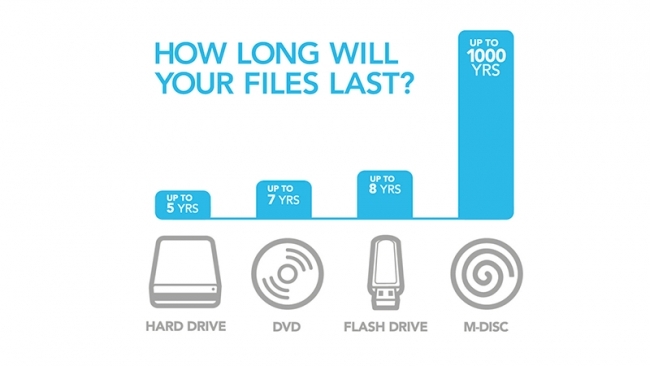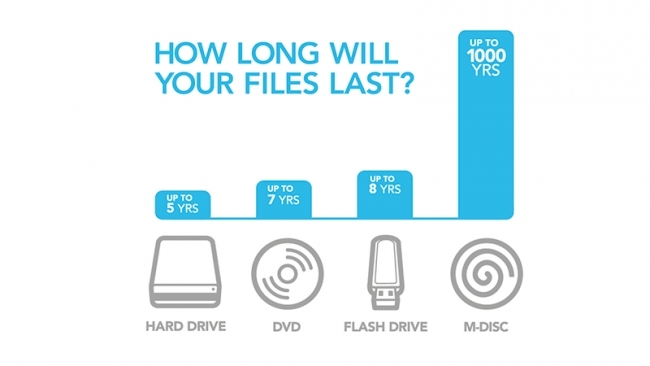
 How long will your files last?
How long will your files last?
Redshark's only 10 months old, and our readership is growing all the time. So if you're a new arrival here you'll have missed some great articles from earlier in the year
These RedShark articles are too good to waste! So we're re-publishing them one per day for the next two weeks, under the banner "RedShark Summer Replay".
Here's today's Replay:
How long will your files last? About 100 years?
When CDs first appeared in the early '80s, Phillips said they'd give us "Perfect sound, for ever". Well, they don't give us perfect sound, and they don't last for ever. Nor do the recordable versions of optical digital media. In fact, they're a lot less robust. But there's a new option, as Phil Rhodes explains
Although it isn't intuitively true, recordable DVDs are, when you think about it, a photographic medium. This is illustrated nowhere better than in a situation I encountered a few years ago which, if you'll forgive the reminiscence, makes the light-sensitive nature of optical disc storage pretty obvious. In fact, you can try it yourself: leave a DVD-R disc on a windowsill for about a year, partially covered in a sheet of paper, and witness the fact that the part of the disc that isn't obscured ends up looking silver, like an industrially pressed disc. Entertaining a thought though this might be for proponents of extremely long exposure photography, it doesn't help much when your DVDs are likely to become unreadable if you leave them in a place that's too bright, or too warm, or if you happen to walk past the cupboard and sneeze.
With file-based recording systems now de rigueur, approaches to backing things up are in notoriously short supply. LTO tape systems, as a complex electro-mechanical arrangement, remain expensive, and almost everyone I consulted in the preparation of this article had experienced problems with the reliability of recordable DVDs and other optical media.
Organic dyes
Traditional green, blue or purple-looking optical discs rely on a layer of organic dye suspended above a reflective layer. “Organic,” in this context, refers to organic chemistry, concerning compounds containing carbon, as opposed to the farming technique which makes potatoes slightly more expensive. The purpose of this dye is to be broken down by the moderately high-power laser beam of the writer, producing either opaque or clear spots where the reader's laser may either pass through to bounce off the reflective layer, or be obscured. This arrangement mimics the physically-stamped pattern of holes (properly, “pits” and “lands”) which are imposed directly onto the reflective layer of a standard CD-ROM, DVD or blu-ray disc.
The original dyes used were based on cyanine, a very old dye formulation which had been used to create blue and blue-green colours for over a century in various applications. The problem is that the formulations suitable for writeable optical media could be extremely unstable when exposed to light. Original cyanine discs – of which I suspect my now half-silvered, sun-exposed one may be an example – could become unreadable in as little as a few years, or mere days when exposed to sunlight. Later formulations, including a stabiliser, improved things, as did the move to phthalocyanine and azo dyes, but the fundamental technique on which all writeable optical media rely is still photographic. The laser in the writer must affect the optical characteristics of the dye, and a degree of changeability in the dye is therefore necessary for the approach to work.
A better option?
Dye-based optical media is the subject of considerable research, and as a tried technology of known reliability it's unlikely to vanish overnight. However, we do now have a potentially better, or at least potentially longer-lived, option. M-disc, produced by US company Millenniata, is an approach to creating writable optical media that immediately seems much more like creating a normal, commercially-pressed disc. Instead of relying on a dye layer and a reflector, M-disc uses a reflective layer of non-organic compounds into which a compatible drive can melt holes with its laser. Exactly what these compounds are is somewhat complicated, but the company likes to refer to data as being “written in stone” because the data layer is made out of metallic, as opposed to carbon, compounds. Well, okay, arguably metal compounds are stone, inasmuch as rust – iron oxide – is effectively iron ore, which is, well, sort of a kind of rock. The point is, though, that this optical medium does not rely on the breakdown of an organic molecule to be written, which means that it is not subject to the same sort of age and light-related degradation as previous technologies.
M-disc does require a specially designed drive to be written. One would hazard a guess that there's a change in the laser energy that's required to melt pits in this “stone” data layer. Rewriteable optical discs which must heat the data layer to the point where its state can be changed are similarly different from more conventional write-once devices, although there isn't any technical data on exactly what the differences are. The company has several well-known manufacturers on board to manufacture M-disc writers, including LG, who're making an aftermarket drive that's far from expensive, so the required changes are presumably reasonably straightforward from a manufacturer's perspective.
Special drives
With regard to the hardware, though, the crucial thing is that while M-disc requires a specifically-qualified drive to write, it can be played back on standard devices – M-disc DVDs, for instance, can be accessed using any DVD reader. This is of crucial importance for archival longevity, which requires not only readable media but also the appropriate hardware to read it. While we can't absolutely guarantee the long term availability of any type of drive at all, the ubiquity of optical disc readers makes it a reasonable choice for an archival format.
As to the actual longevity, M-disc themselves claim that the data layer should last longer than the polycarbonate disc substrate. Since that substrate is projected to last a thousand years, there really shouldn't be a problem, although the ornery critter in most of us will of course raise the issue that nobody from M-disc is likely to be around in the year 3013 to answer any awkward questions. There are of course also a lot of other reasons optical discs become unreadable, from simple incompatibilities between reader and writer, software problems, and simple scratches to the media. Even so, M-disc's new technology does appear to address the majority problem.
The company has released both DVD and Blu-Ray variants of its discs, and although they could be called a little expensive that's presumably just a matter of volume at this point. Blu-ray is big enough to be useful in some HD workflows, although I'm not sure whether there's any plans to offer dual-layer types which are even more useful. The key issue with anything like this is whether it ever achieves a critical mass of market penetration, such that the blank media becomes sufficiently available that it isn't a pain to use. With big names producing the drives and a genuine technological advance on offer, that sort of success doesn't seem impossible.
Tags: Technology


Comments